The President’s press conference yesterday was meant to buttress consumer and investor confidence. I will leave it to others to evaluate whether he was successful in this endeavor [0]. I will also ignore his disingenuous remarks concerning how allowing drilling offshore and in ANWR [1] would somehow affect gasoline prices today in a noticeable manner, and focus instead on his repeated emphasis on the fact that the economy is still growing (although he never mentioned at what pace).
This statement is indeed accurate if one focuses on real GDP. I present the log of real GDP in Chained 2000$, normalized to 0 at the NBER-defined trough in 2001Q4. I also present for reference log GDP in the previous two expansions, normalized to 0 in the previous troughs in 1991Q1 and 1982Q4. (For those interested in output gaps, the mean WSJ forecast predicts output will be 2.7% below CBO’s estimate of potential output by end-2008, in log terms.)
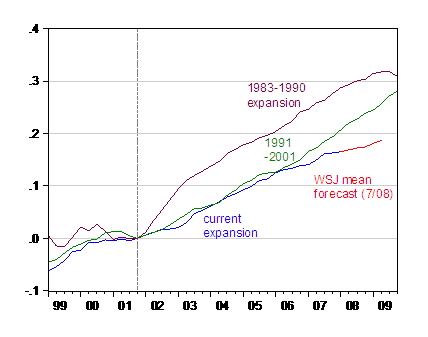
Figure 1: Log GDP normalized to 0 at previous NBER-defined trough, for current expansion (blue), previous 1992-01 expansion (green), and 1982-90 expansion (black). Dashed vertical line at trough. Source: BEA, GDP release of 26 July 2008, NBER, WSJ July survey and author’s calculations.
The graph clearly indicates that GDP is now substantially below (4%, in log terms) where it was at this time in the previous expansion. It is 12% below the corresponding level in the 1982-00 expansion.
I also plot the implied level of GDP assuming the mean forecast from the WSJ survey for GDP is realized. In that case, by 2009Q2, output will be 7% below the corresponding level in the previous expansion.
While the mean forecast is of interest, so too is the dispersion in forecasts. In the figure below, I plot the mean forecast, and the highest and lowest forecasts (using as the reference for highest and lowest the 2008 Q4/Q4 growth rate), from James F. Smith of Western Carolina University and Parsec Financial Management (2.82%), and Paul Ashworth of Capital Economics (0.24%), respectively.
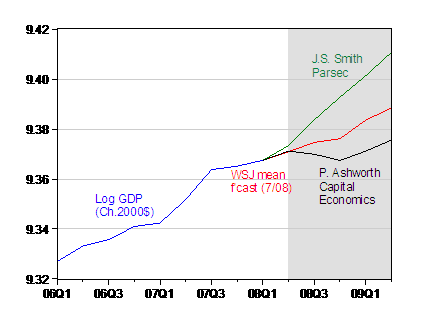
Figure 2: Log GDP in Ch.2000$ (blue), WSJ July survey of forecasts mean response (red), high forecast from J. Smith of West Carolina State U. and Parsec (green), and low forecast from P. Ashworth of Capital Economics (black). Gray shading denotes forecast period. High and Low forecasts based on 2008 Q4/Q4 growth rates, as calculated by author. Source: BEA, GDP release of 26 July 2008, WSJ July survey of forecasts, and author’s calculations.
The mean forecast projects a bump up in growth in 2009Q1. The high forecast by James Smith projects rapid growth all the way through the forecast period. Of course, Smith in the November 2007 survey provided the highest forecast of the surveyed economists for every quarter from 2007Q4-2008Q4, as well as the highest for 2008 Q4/Q4. (In March 2008, Smith also had the highest forecast for 2008Q1 growth, at 2.6%, and tied for highest Q4/Q4 growth, at 3.5%.) The lowest Q4/Q4 forecast comes from Paul Ashworth; he forecasts a 0.24% growth rate for 2008.
In Figure 3, I present a histogram of the 2008 Q4/Q4 growth rates, as implied by the q/q growth rates reported by the respondents to the survey. Smith is the single observation in the top bin. Ashworth is one of four respondents in the bottom bin. Highlighting the skewed nature of the distribution, Smith is more than 2 standard deviations from mean, while Ashworth is about 1.4 standard deviations below mean.
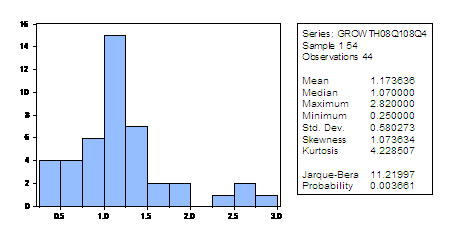
Figure 3: Histogram of 2008 Q4/Q4 growth rates from WSJ July survey of forecasters. Source: WSJ survey and author’s calculations.
If we take the most optimistic forecaster’s view, then by 2009Q2, GDP will be only 4.8% below the corresponding point in the previous expansion. Taking the pessimistic view, it will be 8.3% below.
These forecasts were conducted in the first week of July. Hence, they predate the surprise jump in CPI inflation. Higher than anticipated inflation could have a variety of offsetting impacts. First, it could signal greater demand pressures, so GDP forecasts would be revised upward. On the other hand, taking into account the Fed’s reaction function, one might think that monetary policy would therefore be tighter than otherwise, and hence output — at least several quarters out — would be lower than previously projected.
Today, additional information was released, for industrial production. Here the picture is mixed. Both industrial production and manufacturing production (recall industrial production includes output from utilities which can be influenced by weather factors, even when seasonally adjusted) rose slightly (I think “edged up” is the phrase).
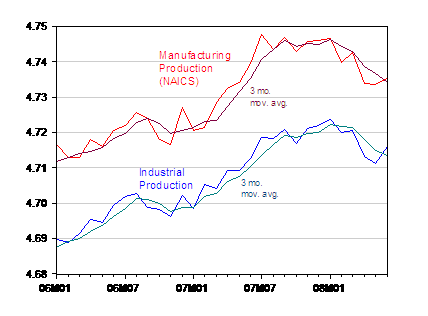
Figure 4: Log industrial production (blue) and log manufacturing production (NAICS) (red), and trailing 3 month moving averages in dark bold lines. Base year for indices, 2002. Source: Federal Reserve Board via St. Louis Fed FREDII, and author’s calculations.
Note that by the metric of the Nation’s factories, utilities and mines, the economy is not growing, over a 3 month moving period.
Finally, both Macroeconomic Advisers and e-Forecasting released estimates of monthly GDP today (May for MA, and June for e-Forecasting). These series are presented in Figure 4. At this point we have a substantial disjuncture between the implications arising from the two organizations’ assessments. E-Forecasting’s figures indicate that in 2008Q2 GDP has declined 0.6% q/q on an annualized basis, while MA is predicting a 2.9% q/q growth rate, taking into account the April and May estimates and a forecasted 0.6% growth (annualized) in June.
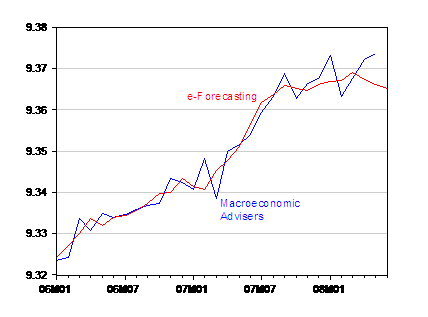
Figure 5: Log monthly GDP (SAAR), from Macroeconomic Advisers (blue), and from e-Forecasting.com (red). Source: Macroeconomic Advisers, and e-Forecasting, releases of 16 July 2008.
Without knowing more about the track records of each of the estimates of GDP, I’m reluctant to say which one better tracks the state of the economy (or, less ambitiously, track the state of the advance GDP release…) . Any informed commentary or references from readers welcome.
What is true is that over the 1992-current period, an estimated error correction model assuming cointegrating between the two series (with long run unitary elasticity) indicates that the MA series reverts more strongly to conditional mean than does the e-Forecasting series. In a statistical sense, then, one might think the last observations of the e-Forecasting series are more likely to be closer to the underlying trend represented by both series (recalling that both series are calibrated to match the quarterly actual GDP series reported by BEA). In an informal sense, I think of this statistical result as meaning that the MA series bounces around more than the e-Forecasting series. This is not a conclusion with economic content, though, as it doesn’t say which series better represents the economy’s state. It might be the case that economic output does jump around a lot, month to month.
Technorati Tags: potential GDP,
recession, output+gap,
industrial+production, forecasts.
Disengenuous indeed. A weakening US economy will drive oil prices down and give Bush II administration apologists an opportunity to say “see, it worked”. This announcement ceterus paribus should put further downward pressure on the US dollar.
I would curious how that cycle growth analysis would look in per capita terms. I suppose US population growth, among the highest of the rich OECD countries, has been relatively constant over the past 3 cycles?
While the USA slowly reduces per capita wealth levels, anybody interested in making some money? Anybody care to suggest an intermediate or small senior exploration & production company well positioned to exploit this opporunity? There should be sufficient time to slowly, carefully research the play.
Canadian multinational Talisman Energy (TLM) has an attractive property in the National Petroleum Reserve in Alaska near the ANWR but TLM is really attractive for a whole host of other reasons including one of the cheapest land packages for unconventional natural gas in North America. I’m not sure if they will risk entering ANWR if the public perception looks risky.
Menzie Chen: Apologies for the hi-jack, but your readers should understand that bad public policy will continue to provide opportunities for individuals to make money. Plus, I’m open to ideas.
When you call remarks disingenous you are hardly ignoring them.
The prospects of a greater supply of oil in the future certainly has some effect on the behavior & pricing decisions of current sellers of oil. At least our feckless president is taking some initiative to increase the supply of domestic oil, in contrast your wonderful Democrats.
The end of the commodity boom will lower industrial production and surge job losses. I have been calling for this since late last year that if commodities top, we disinflate and the slash signal will be given triggering a basin wide manufacturing slump. It has been the commodity surge that has helped exports and over ordering which has created a inventory mess but propped the economy. With it gone, that all goes away and the correction will tank the economy for a few quarters while everything corrects.
The commodity boom was a good thing for the US economy. Mentally, the reaction has been in error and based on 70’s mis-remembering of the embedded inflation crisis. This is a way different economic system that thrives on price inflation in the materials because they don’t impact consumption levels(just choices). Price declines in materials is destructive to the economy and leads to collapse.
That is why when Bernanke sits at this congressional testimonals and is almost about ready to laugh like a cat, knowing what they don’t know while he “jawbones” about inflation. Deflation must be stopped with all force, because if it wins, a economic winter will set in.
I don’t know much about who is better between e-forecasting and MA, but I haven’t heard of any other private forecaster projecting a negative Q2. Morgan Stanley is current at 2.4%. Paul Kasriel, who tends to be more bearish, is at 1.5%.
Nice work, Professor. Should be an interesting release on Q2 GDP.
One release on real retail sales shows them down two of the last three months:
http://research.stlouisfed.org/fred2/data/RRSFS.txt
I don’t know much about who is better between e-forecasting and MA, but I haven’t heard of any other private forecaster projecting a negative Q2. Morgan Stanley is current at 2.4%. Paul Kasriel, who tends to be more bearish, is at 1.5%.
Yes, most of these “projections” are based on the materials/commodity surge, though they may be overly optimistic. Other forces may have drug down GDP such as the deepening goods depression and commercial RE slump impacting GDP more than they think.
Of course you know what material disinflation will do to GDP in Q3 as inventory is worked off.
algernon: Sure, doing present discounted values, of course what is expected to happen ten years down the line must have some impact, but I did include the adjective “noticeable”. So, for me, the point stands.
Menzie says:
“Sure, doing present discounted values, of course what is expected to happen ten years down the line must have some impact, but I did include the adjective ‘noticeable’. So, for me, the point stands.”
Ten years from ground to pass through? I’ve heard, from experts (people that do this for a living as opposed to those that hypothesize about the issue) , five (optimistic) to seven years.
Drilling is not an activity that excludes the move to alternative fuels such as nuclear, wind, and solar.
Menzie, you do not want to drill at all do you? You are a proponent of nuclear are you not?
algernon: 10 years? I would think more like 15 to 25 years. The US economy could have gone through 2 or 3 business cycles before the bulk of this newly liberated oil comes to market.
By making this a partisan issue, you do yourself, your country and your country’s allies a gross disservice. American energy incompetence dates from colonial settler traditions and cuts across all partisan lines.
Demand should be disciplined.
Menzi wrote:
The President’s press conference yesterday was meant to buttress consumer and investor confidence. I will leave it to others to evaluate whether he was successful in this endeavor [0]. I will also ignore his disingenuous remarks concerning how allowing drilling offshore and in ANWR [1] would somehow affect gasoline prices today in a noticeable manner…
Menzie,
You seriously weaken the impact of your anaysis with comments like these. It automatically indicates a bias to your work and paints your work as political analysis rather than economic analysis.
Consider how much less off-putting it would have been if your introduction paragraph had been.
The President’s press conference yesterday was meant to buttress consumer and investor confidence. I will focus instead on his comments that the economy is still growing (although he never mentioned at what pace).
I know that I for one would have been interested in what you had to say. As it is I have not read your analysis yet because of the knot in my stomach.
Algernon:
You realize of course that in making a mildly pro-Bush statement you are a partisan but when spreading anti-Bush propaganda you are just honest.
The solution to the energy mess is to attack it across several fronts, more domestic drilling, alternative energy sources, more nuclear plants, as well as conservation (and on that point I will criticize the Bush administration). There is no silver bullet. I would be interested in hearing anyone’s comments on the Pickens Plan.
Menzie Chinn: Is it hard to bash Bush while also trivializing (well-documented) allegations that inflation is understated?
Cause, you know, the real GDP is a weeeee bit lower if you accept inflation being higher…
Algernon, the dishonesty in your approach is the implicit assumption that domestic oil production has an effect on domestic oil prices – which, of course, it doesn’t; it has its effect on the WORLD price of oil – and any such effect would be trivial given how much oil production we could feasibly bring to bear. Whether we produce 5% or 95% or 155% as much as we consume is irrelevant.
Unless, of course, we nationalize ‘our’ oil and then subsidize the price for local buyers. Is that what you Republicans have in mind? The Hugo Chavez plan?
DickF: I note that you have not taken issue with the points. If they are indeed true, then should I not say them. But I accept that you might in the future skip my posts.
Babinach: Please have your friends contact the authors of the DoE/EIA report, as well as CRS specialists, to educate them.
Silas Barta (formerly Pereson): CPI and the PCE deflator are related, and share some data, but are different. Now, you could assert that the PCE deflator has been distorted as well — and then we could get into a whole other discussion.
Algernon, the dishonesty in your approach is the implicit assumption that domestic oil production has an effect on domestic oil prices
Why is that an implicit assumption. I wouldn’t assume that he was making that assumption. 😉
If all the price increases in the last year all stem from a 1MBPD cut in production by the Saudis in ’06 (it was certainly one factor), then increased domestic production could have a huge impact.
Menzie,
You are wrong. Opening up more acreage to exploration will affect psychology and markets. let me explain.
A credible threat of increased supply – even ten years away – certainly does have immediate impact to the ruminations of energy policy makers from Russia to Saudi to Mexico.
If you have a large control over marginal supply (Mideast/Russia/Mexico could all do a lot more if they choose to) and you see the glimmer of another North Sea or another ANS then you rightly might adjust your policies. Strategically speaking, if you dominate global oil supply then at some price point you rightly begin to fear Competitive Entrants.
In Marketing this is sometimes called the danger of a “holding up a price ummbrella”…if you do not have a differentiated product then high prices will ultimately lead to a loss in market share to competitive entrants who are attracted to the higher margins.
In the case of Oil (by no means a free market), governments control access to resources (sell it like real estate and demand whatever they like or in many cases simply make everything off limits to private capital). However, if you push oil importing nation governments too far with overly high prices then you just might trigger competition.
I hope this makes it clear that the main reason we pay such high oil prices today is the government RESTRICTED ACCESS to reserves (a global phenomenon) that has tended to dominate the oil industry landscape for so long. The secure knowledge that the US Government is EXTREMELY UNLIKELY to open up new reserves for exploitation is enough to keep exporting nations confident that they can safely continue to extract higher rent for their commodity.
So just the credible threat of a surge in new competition (a la Bush statement) may be enough to open the taps a bit more or cause a flurry of counter-competitive increased supply activity to quickly try to KILL the new threat or frighten off competitive capital investment in new supply..
Of course it has to be a credible threat. I don’t think what Bush said is at all credible, however, because most Americans think like yourself. They just don’t understand global strategic competition between companies and nations.
Think Strategically. BTW – I condemn Bush for many things and I sympathize with your attitude towards this administration, however, for once, Bush is actually right this time!
For further reading to understand the above, you need to study Michael Porter’s Competitive & Strategic theories from the 80’s. Alternatively read Barry Nalebuff’s book about Thinking Strategicaly – it even includes an example of a game theory table that explains how swing producers think.
BTW – You and James are doing an absolutely tremendous job on your “economics” website – I would not bother with such a lengthy post/explanation if I did not deeply appreciate the service and insights you both bring! Keep it up – you are a bright light in a sea of misinformation.
I’ve never understood what the point is supposed to be of comparing different expansions “by growth rate from trough” — at least when the comparision is made without noting the unique conditions in which expansion occurs, and how hugely different the conditions usually are between them.
(OK, I understand it when people whip out these comparisons for political reasons — but not for the purpose of economic analysis.)
For instance, the ’82 bottom was the worst since the Great Depression, with double-digit unemployment, etc. One would expect and hope that the recovery from it would much higher relative to that bottom at any subsequent point in time than in any other any other cycle. The ’91 recession was pretty serious too, with unemeployment at 7.8%. The ’01 recession was among the mildest on record, with unemployment barely tapping 6% — a high that was lower than than the rate for five years after the ’82 bottom.
So ISTM that when comparing “growth from the trough” in each cycle, one should note the depth of the trough.
Each cycle also takes place in its own different world too, pretty much literally. As one simple example relavent to this blog, after both the ’82 bottom and the ’91 bottom the price of oil plunged for years on end — at this point in time after the ’91 trough, OPEC was in apparent collapse and oil in the US was selling at $8 a barrel. While in this cycle oil has surged up from very near that all-time low to all-time highs circa $140.
Do we really learn anything meanignful from simple “growth rate from trough” comparisons of different expansions that omit all consideration of such differences?
I might add that at this point after the ’82 trough the expansion was about to slam into the ’90 recession, and after the ’91 trough it was closing in on the ’00-01 recession. But next year maybe the banks will finish sorting themselves out and start lending again, oil will drop back to $70, and we’ll have several more years of expansion, longer than both the prior cases. Who knows? Does anything in those three graph lines preclude it? So I don’t see the point.
Okay Menzi.
The President’s press conference yesterday was meant to buttress consumer and investor confidence. I will leave it to others to evaluate whether he was successful in this endeavor [0].
The president had to speak. If we look at the market we can see that the coordinated efforts of Treasury, the FED and the President did in fact bolster the market and lead to a rise in Fannie and Freddie stock. The only problem with such statements is they need substance to support them. But with our existing Democrat congress that is doubtful. The president has the Bully Pulpit but congress holds the purse strings and right how they have their hands way down deep in the purse (consider Chris Dodd and his sweetheart deal with Country Wide, or Chuck Schumer single-handedly creating a run on the bank so that no deal could be worked out to save Indymac to limit customer losses.)
I will also ignore his disingenuous remarks concerning how allowing drilling offshore and in ANWR would somehow affect gasoline prices today in a noticeable manner,
“Noticeable” is a loaded word. Of course announcements that the government would get out of the way would immediately affect prices of oil and gasoline as worldwide speculators reassessed their positions and yes, it would be noticeable. It would probably even be commented on here. I don’t understand why political hype makes a serious economist suspend the laws of supply and demand.
and focus instead on his repeated emphasis on the fact that the economy is still growing (although he never mentioned at what pace).
As you note contrary to the hopes of the President’s enemies (are you one?) the economy is still growing though slowly. There is worldwide concern about the US. The FED is failing miserably to stabilize the dollar and the Democrat Congress is destroying international trade (such as not allowing a vote on the trade deal with Colombia), making the crisis with Fannie and Freddie worse (Barnie Frank and others talking of having Fannie issue loans for low income housing), and notifying the world that taxes will increase (Bush tax cuts will not be increased). Combining that with the possibility of the return of Great Depression, New Deal government policies with Barak Obama New Deal Ponzi schemes, is there any wonder that we have seen a return to stagflation, higher unemployment, and a slowing economy.
I will only skip your posts until I compose myself. I am here to try to understand the reasoning of those enamored with Fascist central planning.
What about taking time to LISTEN TO AL GORE’s speech about alternative energy – TODAY.
PEAK OIL is happening.
CLIMATE CHANGE is happening – google “Pentagon Report on Climate Change” – been around since the ’80’s.
CHANGE is coming whether WE HUMANS like it or not!
Letting the folks that got us into this mess off the hook is NOT THE ANSWER.
Pulling together with EYES WIDE OPEN, is one of many answers.
Namaste.
—
WARNING: Due to Presidential Executive Orders, WITH CONGRESSIONAL APPROVAL, the National Security Agency may have read this email without warning, warrant, or notice. They may do this without any judicial or legislative oversight. You have no recourse nor protection save to call for the impeachment of the current President, 69 members of the Senate and 293 members of the House of Representatives.
Anon-
Thanks for the comic relief!
Jim Glass/DickF-
I second your thoughts.
Jim, you don’t get it. If Oil drops back to 70, then the economy has collapsed along with industrial production. You are thinking backwards. Oil hasn’t done NEAR the damage people thinks it has:
1.Has it effected consumer spending? Nope, even though gas prices were elevated, they were at levels that will cause little disturbance in the credit card cycle. Any shortfalls were taken up on plastic which is at the end of its credit cycle. When the credit card cycle ends, it will weaken consumption a good deal(really from weak to horrid as the debt load is gotten rid of).
2.Transportation: Yep, higher prices, which fed into some higher prices for a period, but except for some small players going backrupt and some very modest layoffs(nothing that would come close to a manufacturing basinwide recession) it didn’t do squat as they adapted. The effing media blew this up way to much. America is wrong. It will be a riot when they grow more “confident” but their spending goes down due to surge in layoffs. Funny as hell.
Commodities(really industrial materials) have been the bedrock of this industrial expansion this decade which lead to exports to supply the global boom. But in June there were signs that globally, economies were beginning to run out of gas. Inventory has been shooting up but June was absurd.
We have to remember this has been a mild goods recession so far. That is why alot of the “traditional” economic indicators have not caught it because they are not able to in their data. When those indicators tank, you know it is bad.
That is bad omen for the US. No long expansion is coming, a long recession instead.
“Do we really learn anything meanignful from simple “growth rate from trough” comparisons of different expansions that omit all consideration of such differences?”
Yes, we learn that regardless of the credentials of the writer, if they have a political axe to grind they will find methods of manipulating data to their end. It isn’t a simple partisan issue, everyone does it whether they’re doing so for ideological reasons, for gold-peddling reasons or other reasons impacting on their profession (often times authors, financial advisors, and others fall into this category), or whether they simply like to portay themselves as the prescient doomsayer. (Not a hard task to do if you keep beating the same drum long enough.)
In figure 1, how did you extend the 1983-90 expansion to match the length of the 1991-01 expansion?
anon: Thanks for the compliment. I appreciate the substantive nature of your comment. I’m not a game theorist, but as I recall, the argument you pose requires some proper configuration of parameters (and type of leadership in setting either prices or quantities) in order to work. One particularly important parameter is, I think, the cost parameter. To the extent that even with the allowance for offshore drilling, the United States is not the low-cost producer, I’m not sure that the threat to produce more will induce greater production elsewhere. But I’ll leave the game theorists to elucidate whether I have this conjecture right or not. This relates to buzzcut‘s point about the 1 mbpd Saudi cut in 2006; the Saudis are the low cost producer — what they do has a different strategic impact than what others do.
travis: Good point — I should have truncated the last few observations for the 1982-90 expansion.
DickF: For a person decrying my use of inflammatory language, your choice of the phrase “Fascist central planning” seems interesting.
I am not an enemy of the President. In fact, if you know my record, I worked for the President. I am an enemy of bad policy and bad policy analysis.
Finally, I have been referencing several documents put out by the CBO and EIA in regard to energy. If you think they don’t understand the laws of supply and demand, well, I think the conversation ends there…
Jim Glass: I understand your points. Then you can dispense with those references (and the rest of the NBER business cycle dating methodology of Burns et al., plus discussion of trends and cycles in general). Please refer to my posts discussing the level of output relative to potential, here. Of course, if you don’t believe in trends and cycles characterizations, you need to ignore HP filters, and band pass filters. And pretty much any other time series filter in the time or frequency domain I can think of…
Menzie,
I have explained my use of the term Fascist central planning before, but let me define it again.
First, I do not use the term as a pejorative. Fascism has a specific meaning concerning economics. It was the system used by Mussolini in Italy to make the trains run on time, and it was embraced by most of the world in the 1930s. It is a system where the government determines what and how much should be produced through regulation, taxes, and direct coercion.
If we contrast the United States and China for example China is becoming less Fascist as they move more and more to a free market. The United States on the other hand is becoming more Fascist as the government regulates more and more. This is especially true when it comes to oil, education, and health care, but is seen in almost every other industry to some extent.
So when I use the term Fascist central planning I am not attempting to insult. I am atempting to describe the system in the clearest terms. It is too bad that the term Fascism has been so distorted by the horrors of WWII in Germany and Italy. Fascism is actually not concentration camps and gas ovens but that is usually the assumed meaning. The Fascism of Franco’s Spain comes closer to the original. The whole idea of Fascism has lost its meaning today and so the parallels of the failed Fascist central planning of the 1930s and 40s to the Fascist central planning of today cannot be easily discussed without giving offense.